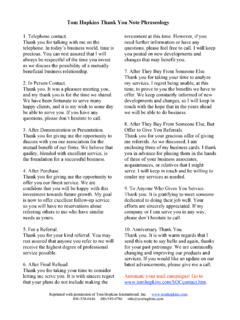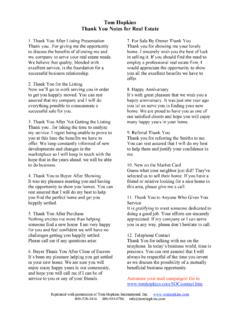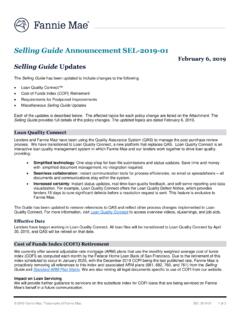Transcription of How to Master the Art of Selling - Tom Hopkins
1 How to Master the Art of Selling Tom Hopkins Copyright 2005 Tom Hopkins International, Inc. 1 How to Master the Art of Selling by Tom Hopkins , America s #1 Sales Trainer FOR MAXIMUM RESULTS FROM THIS BOOK, PLEASE READ This book is written to show you how to make money in sales and to get more out of life. I encourage you to do more than just read this book. Take notes, use a high-lighter pen to mark the book in any manner you see fit or anything else that makes this book a more effective tool for increasing your income. AUDIO PROGRAMS It is imperative that you try as rapidly as possible to get my techniques into your subconscious mind so they become part of you and come out automatically in your own words. In today s hectic world, many of us don t have the time to read as often as we would like. Because of this, many of the top salespeople we train absorb the material easier by listening to audio recordings while doing other activities. If you have a challenge with making time to read, I heartily suggest you consider our audio training program, How to Master the Art of Selling Anything.
2 It s available in both compact disc and cassette from our home office in Scottsdale, Arizona or on our web site at These programs were recorded in lecture format with a live studio audiences. They cover all the basics of the profession of Selling . Topics covered are: 1. The Profession Called Selling 2. What is a Champion? 3. Control with Questions 4. Minor Reflexive Questions 5. Emotions, the Triggers of Selling 6. How to Handle Failure and Rejection I 7. How to Handle Failure and Rejection II 8. Referral Prospecting 9. Non-Referral Prospecting 10. Telephone Techniques 11. Pre-planning your Sales Presentation 12. Contact How to Master the Art of Selling Tom Hopkins Copyright 2005 Tom Hopkins International, Inc. 2 13. Qualification 14. The Visual Aid Presentation 15. Presentation Demonstration Tactics 16. Objections Premise 17. Objections Solution 18. Test Closing 19. Anatomy of a Close 20. Power Closes of a Champion I 21. Power Closes of a Champion II 22. Turning Little $ into Big $ 23.
3 Time Planning Organization 24. Goal-setting MOTIVE My primary concern in telling you about these audio programs is your success. I know personally how lonely and frustrating the life of a salesperson can be. When I started, I was as much as failure as anyone until I was able to get the proper training to insure my success. At that time, I swore if ever I could share my success with others, I would do it with high quality and at an investment that anyone could afford. You may feel that I am trying to sell you something and that is true. We are in the business of Selling just like you. However, if you know something is good, you have an obligation to offer it to your client. You will make a small investment for these audios and that constitutes one sale for us. However, it may mean hundreds of sales in your career and thousands of dollars for you and your loved ones. In this way, I hope that my company can play some part in your continued success. Thank you. How to Master the Art of Selling Tom Hopkins Copyright 2005 Tom Hopkins International, Inc.
4 3 Chapter 4 CREATING THE Selling CLIMATE A Champion only sells the benefits and features that the prospect he's working with wants to buy. For years, I've monitored this point, and I'm convinced that it's critical to success: don't sell what you want, sell what they want. It's astonishing how many salespeople only talk about, explain, and try to sell the features of their offering that they like. "Oh, I just love the fact that it slices grapes," and the prospect doesn't give a hoot about what you love. "You know, I've got this same policy in my own investment portfolio," and the prospects don't see what that has to do with their investment decision because your circumstances are different than theirs. "When you step on the gas in this beast--look out. It's gonna ram you back in the seat. It's gonna peel rubber." And the prospect is a conservationist who worries about the high cost of fuel and wants an economy car. The Champion doesn't sell benefits before finding out what benefits the prospect wants.
5 The average salesperson plunges into Selling benefits from the start and, inevitably, he has the prospect sitting there thinking, "None of this stuff I'm hearing is important to me." Keep that up for a little while and the prospect leaves if he's on your premises, or you do if you're on his. I'd like to be sure that we're together in this area. Who pays for your product or service, you or the buyers? Of course the buyers do. Then we should give them what they want. Doesn't that make sense? We should sell them the features that will give them the benefits they want. How does this fit my teaching that you should make decisions for your clients? Neatly. People want more than they can get. Money is only one of the great limitations that we all have. Time is another. People want their cars to be larger on the inside and smaller on the outside, their meals to be more delicious and less fattening, their investments to have higher return and lower risk. They want it all but you know they can't have it all, so you have to decide, among your many products and services and their many desires, what specific item will work best for them.
6 In most cases, you can't afford the time to show them everything, and lead them step by step over every square foot of your knowledge to the one item they'll buy. That's not efficient, not professional, not money-making. The purpose of your consultation interview (which might be a few quick questions on the phone to prospects, or a longer face-to-face interview in someone's office) is to diagnose their challenge, and determine what their opportunities are. Following that interview, you decide how to proceed. This process requires that you decide not How to Master the Art of Selling Tom Hopkins Copyright 2005 Tom Hopkins International, Inc. 4 to discuss a wide variety of possibilities with them that you have the professional expertise to know they won t buy anyway. Part of your service is to save their time as well as your own. SELL THE PEOPLE WHO CAN BUY Many salespeople spend endless hours with people who can t say yes. In commercial/industrial/government sales, this is an ever-present problem.
7 Typically, you can t walk in and talk to the person who is in charge. In many cases, you ll be told that no one individual will make the decision you see, that all such decisions are the sole prerogative of the board of directors, trustees, a committee, or whatever. When you re told that, you ll almost always be given to understand that every member of the decision-making group is away and unavailable. In essence, they are unreachable. What you re hearing is the truth it s just not all the truth. The committee exists. It meets regularly. It can make decisions. All important decisions are approved by it. And its members are, for all practical purposes, unavailable to you. Under the law, or in the by-laws, all the power in that organization is given to that group. However, such unreachable committees rarely exercise any power that s important to you. They have it, but they don t use it because there s too much complexity and too little time. Willingly or not, the directors, trustees, and various boards of this and that have to rely on the nameless gnomes in the backrooms for recommendations that they will likely approve or disapprove.
8 Of course, the gnomes are nameless only in the sense that they don t sign annual reports or get mentioned on cornerstones. But their signatures activate purchase orders. There are few situations in sales that are more complex and easier to botch than the unreachable committee. In no other area will your sensitivity to small clues and the subtle nuances of power be better rewarded. Organizations have purchasing procedures that involve several people, much time, more paperwork, and they all move through clearly defined and tidy channels in complete conformity to law and the dictates of their governing bodies or owners. That s the face the organization shows to the world, and it has the paperwork in its files to prove that everything has been done according to their book. In reality, though, very little is done according to their book, and the real decisions are made outside the tidy channels. The paperwork to justify those decisions is then created after the event. Flexibility is vital in these situations.
9 Rigidity is dangerous to your success. Keep the ideas that follow in mind when you work with the unreachable committee situation and they ll frequently help you find your way follow them blindly and they ll sometimes take you off the road and over the cliff. The gnomes in the back room are insecure, and jealous of the power wielded by the whim of the committee. Make the gnomes feel important. Never let a gnome suspect that you re How to Master the Art of Selling Tom Hopkins Copyright 2005 Tom Hopkins International, Inc. 5 anything but delighted that you can work with him instead of whoever has the title and the official authority. Have faith in the value and importance of your offering to that organization. You need that faith, but don t let it blind you to the fact that most of the unreachable committee will be too involved with their own pet projects to care very much about yours. Never hint that you ll try and end run around the gnome to the committee unless you re willing to accept the gnomes enmity.
10 Unless you can somehow reach the unreachable committee and sell it on your proposition , you probably need the cooperation of the gnome to close that organization. Keep that in mind from the first moment you think about Selling to them. Make sure you re working with the right gnome, not some chair-warmer whose main job is getting rid of the salespeople the right gnome thinks he doesn t want to talk to. There are two kinds of gnomes: those who relish displaying their power by committing themselves, and those who ll never commit themselves. Never try to get an iron-clad commitment from a reluctant gnome it can t be done. If you can t sell the gnome within a reasonable time, and if you think that organization is worth more of your time, try the end run. If you can t find a way to reach somebody on that unreachable committee through friends, political connections, or by direct and persistent pursuit, go over the gnome s head to anyone strong enough to push your proposition past him.








